Abstract
Ampicillin killing curve patterns for 20 strains of ampicillin-susceptible nontypeable Haemophilus influenzae were determined by the agar dilution plate count method. The paradoxical effect was detected in the 24-h killing curve patterns for each strain. For the biphasic effect, minimum survivor percentages (maximum killing) occurred over a narrow range of ampicillin concentrations immediately above the MIC, with survivor percentages then rising rapidly to peak at approximately 1-log10-unit increment higher. The 24-h minimum survivor percentages for the 20 strains ranged from approximately 0.01% (rapid killing) to greater than 10% (slow killing). In comparison with the previous results for typeable strains, the present findings suggest that nontypeable stains are, on average, killed much more slowly. Based on the initial 24-h killing curve patterns for the 20 strains, 4 strains were selected as putative representatives of the range of bactericidal responses encountered. These strains were then studied to examine the reproducibility of the 24-h patterns and to determine sequential killing curves. These patterns were found to be reproducible and served to characterize the relative killing responses of the strains. In the sequential studies of three of the four strains, tiny colonies having the gross and microscopic characteristics of L-forms were found to be present on the agar dilution plate count plates prior to the application of penicillinase at 48 and 72 h. Such colonies reverted to vegetative forms within 24 to 48 h after application of penicillinase to the panels. Of particular interest was the observation that the paradoxical effect was manifested both by the L-form colonies and by the reverted vegetative colonies. The late development of L-forms was observed for both rapidly and slowly killed strains.
Full text
PDF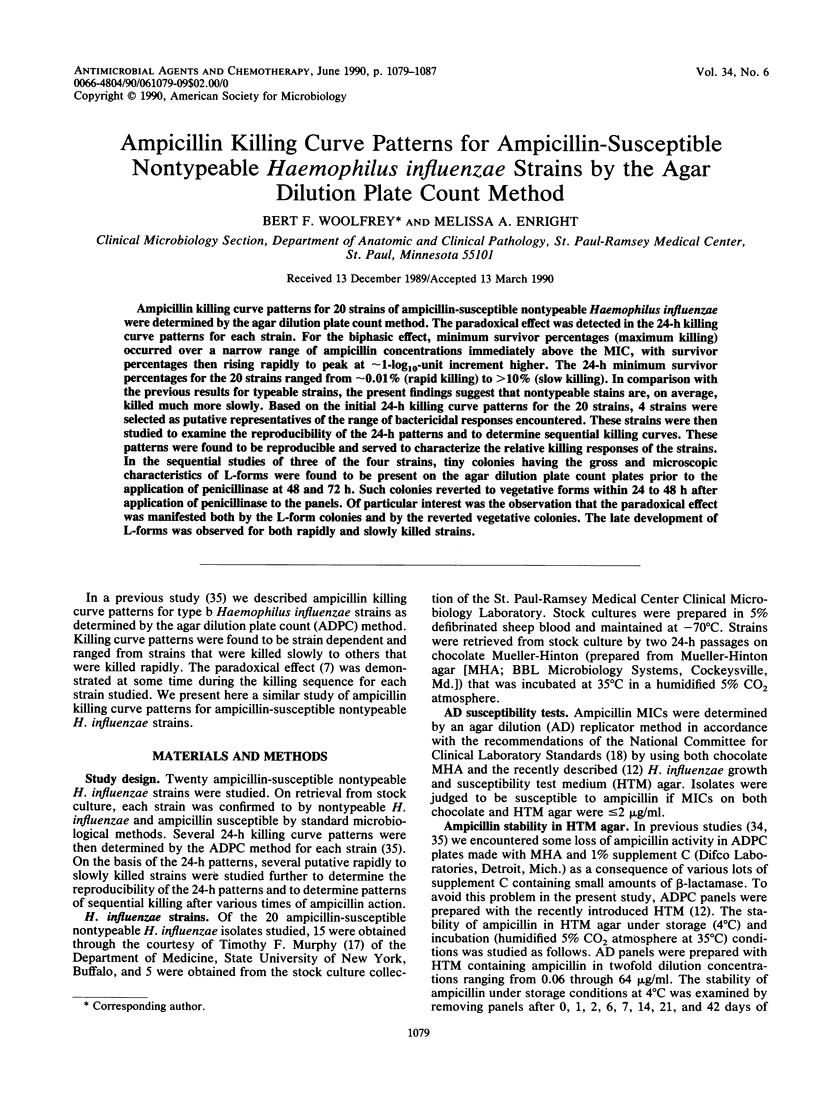
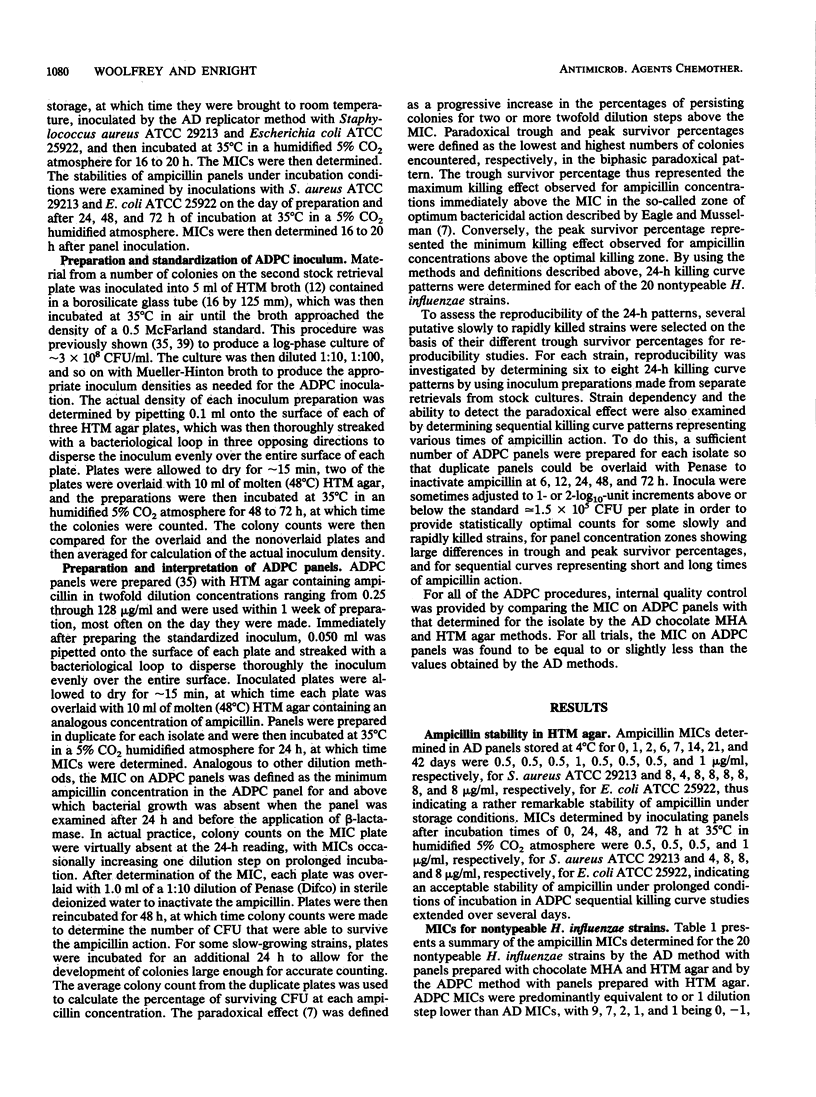
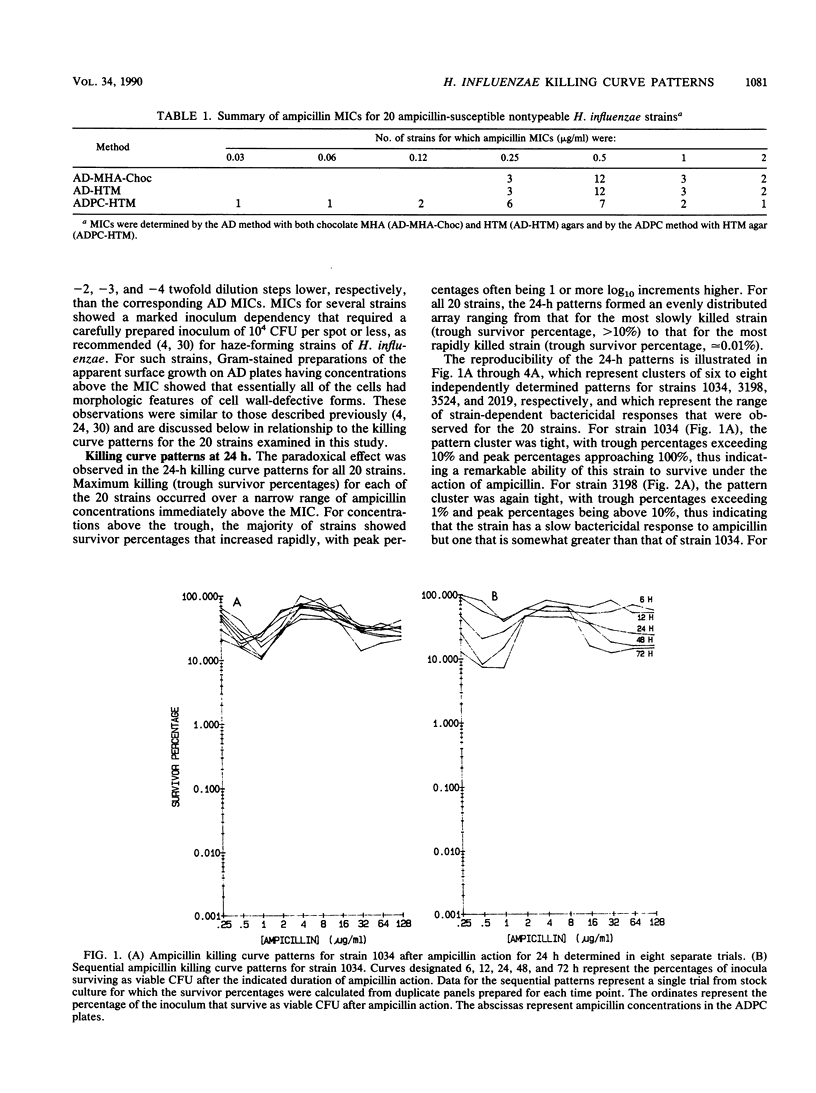
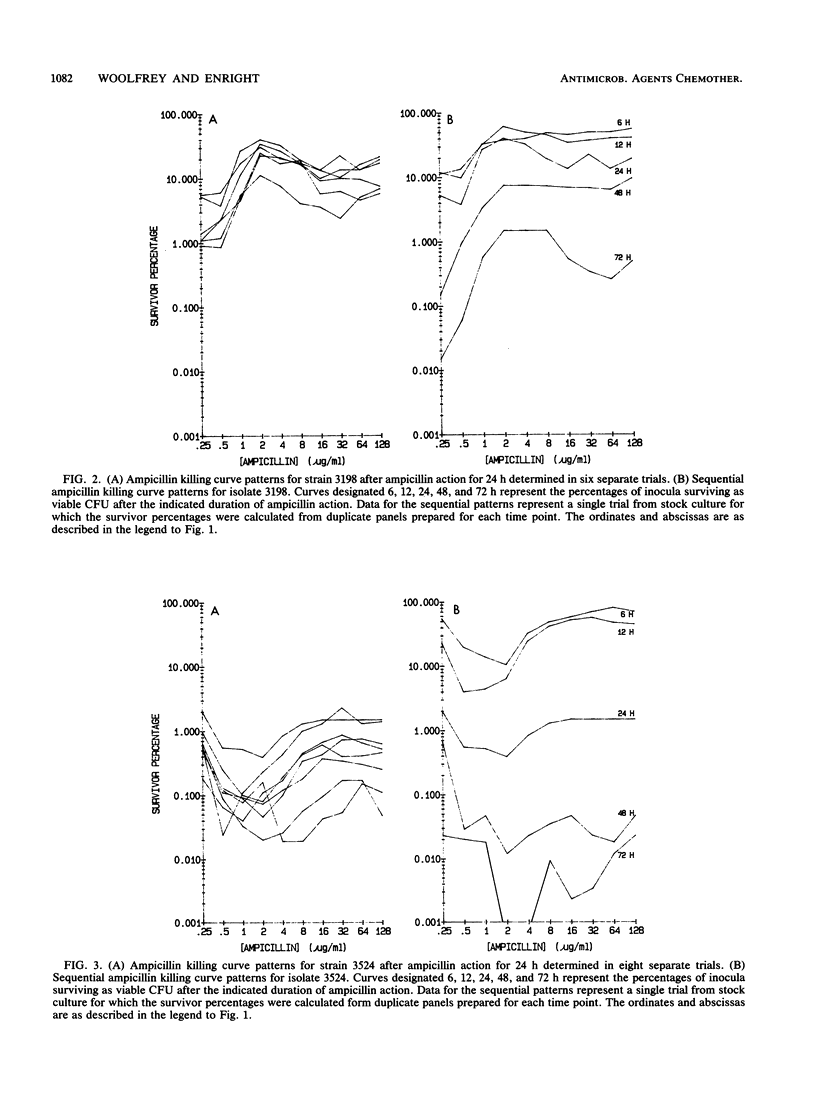
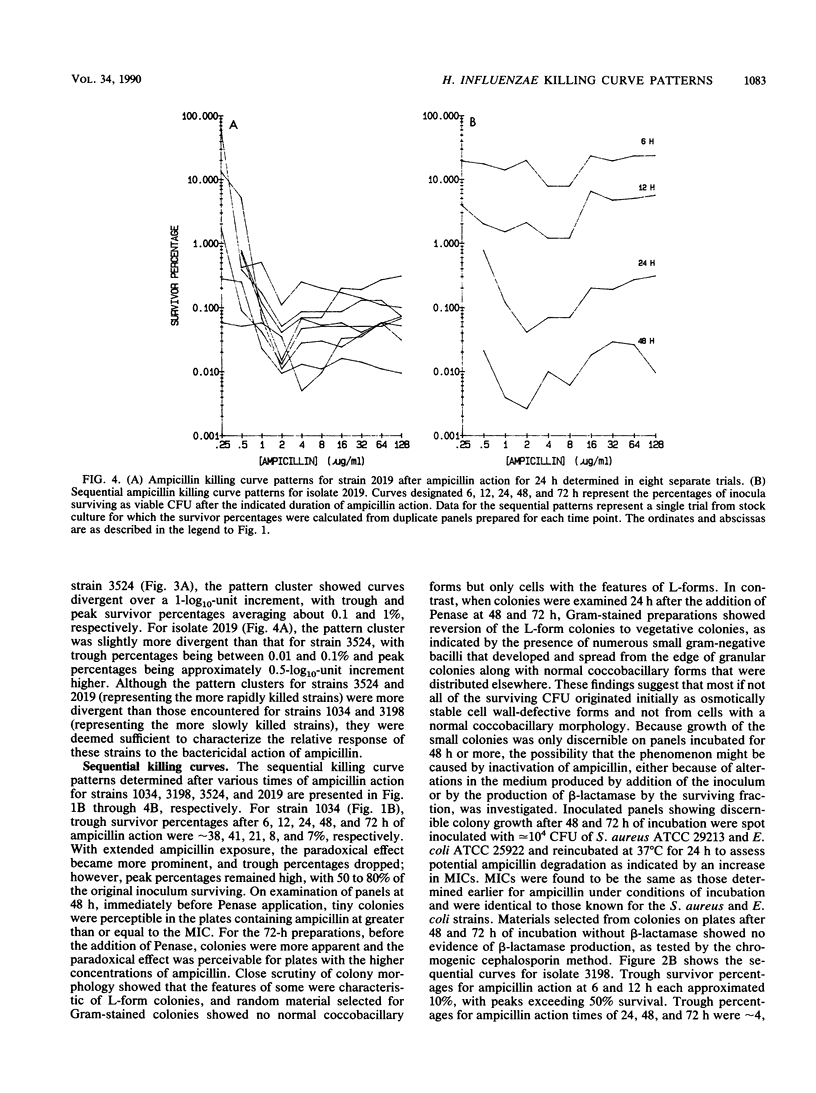
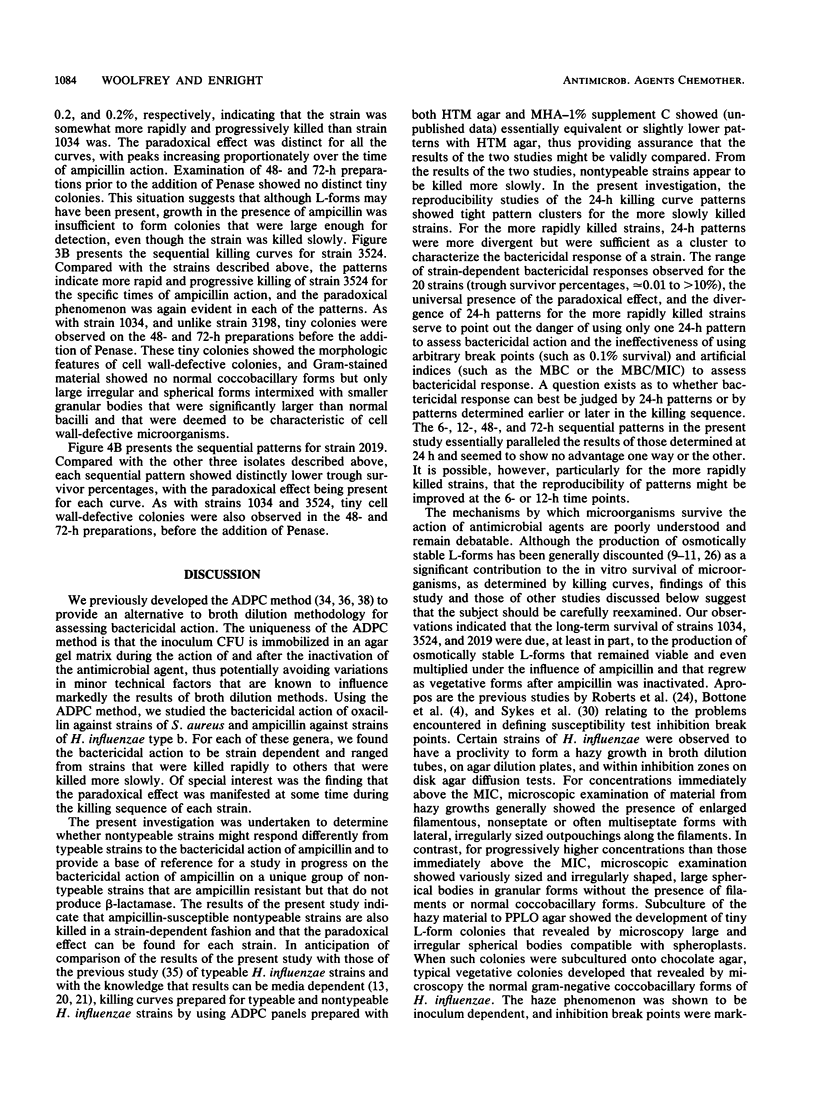
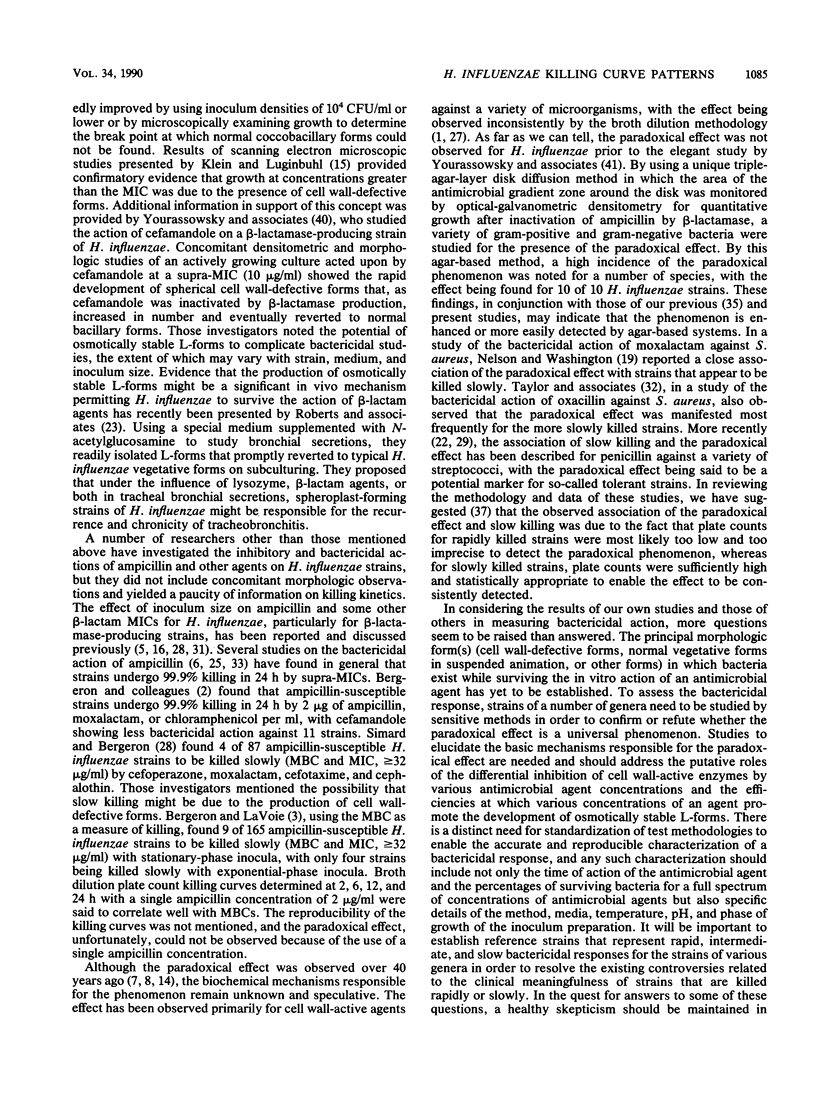
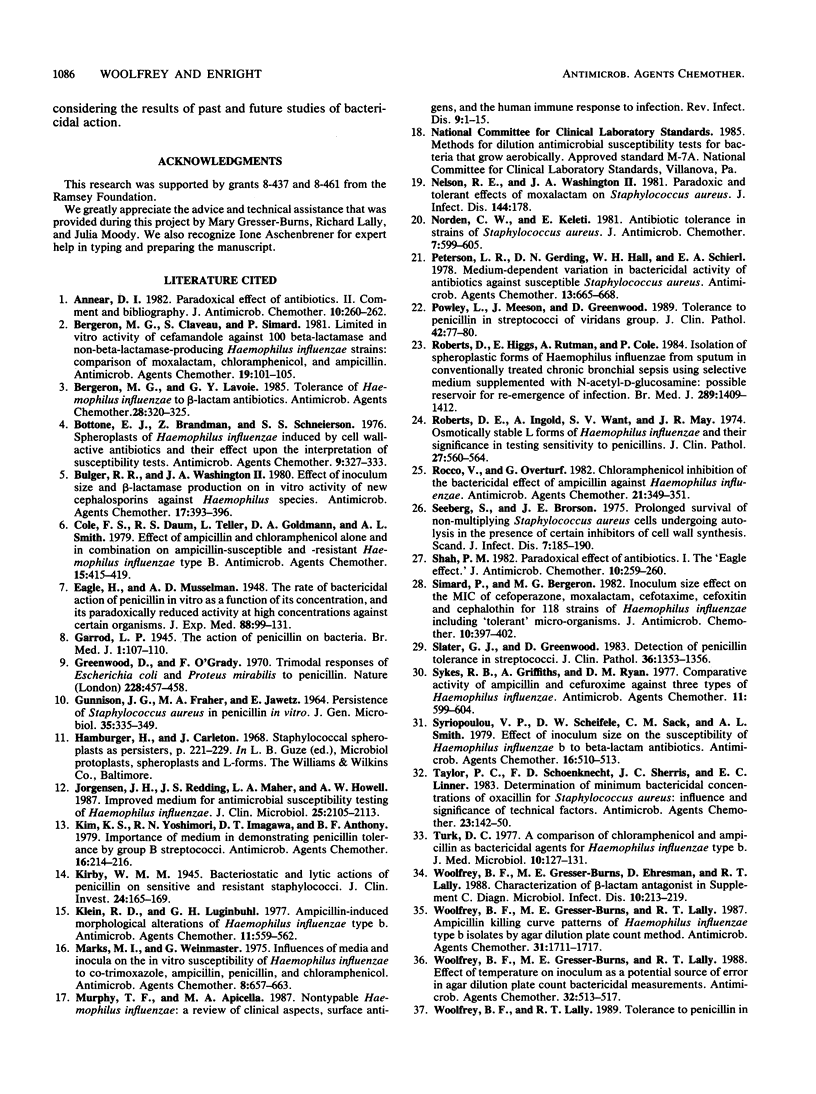
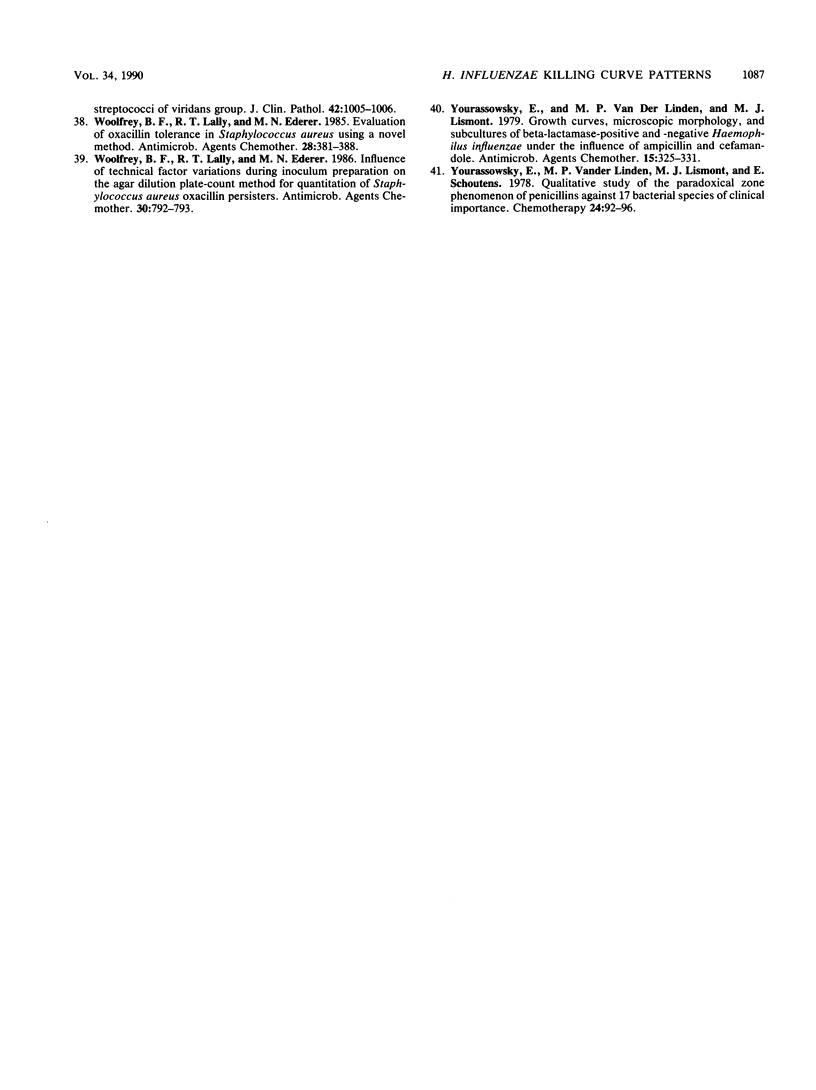
Selected References
These references are in PubMed. This may not be the complete list of references from this article.
- Annear D. I. Paradoxical effect of antibiotics. II. Comment and bibliography. J Antimicrob Chemother. 1982 Oct;10(4):260–262. doi: 10.1093/jac/10.4.260. [DOI] [PubMed] [Google Scholar]
- Bergeron M. G., Claveau S., Simard P. Limited in vitro activity of cefamandole against 100 beta-lactamase- and non-beta-lactamase-producing Haemophilus influenzae strains: comparison of moxalactam, chloramphenicol, and ampicillin. Antimicrob Agents Chemother. 1981 Jan;19(1):101–105. doi: 10.1128/aac.19.1.101. [DOI] [PMC free article] [PubMed] [Google Scholar]
- Bergeron M. G., Lavoie G. Y. Tolerance of Haemophilus influenzae to beta-lactam antibiotics. Antimicrob Agents Chemother. 1985 Aug;28(2):320–325. doi: 10.1128/aac.28.2.320. [DOI] [PMC free article] [PubMed] [Google Scholar]
- Bottone E. J., Brandman Z., Schneierson S. S. Spheroplasts of Haemophilus influenzae induced by cell wall-active antibiotics and their effect upon the interpretation of susceptibility tests. Antimicrob Agents Chemother. 1976 Feb;9(2):327–333. doi: 10.1128/aac.9.2.327. [DOI] [PMC free article] [PubMed] [Google Scholar]
- Bulger R. R., Washington J. A., 2nd Effect of inoculum size and beta-lactamase production on in vitro activity of new cephalosporins against Haemophilus species. Antimicrob Agents Chemother. 1980 Mar;17(3):393–396. doi: 10.1128/aac.17.3.393. [DOI] [PMC free article] [PubMed] [Google Scholar]
- Cole F. S., Daum R. S., Teller L., Goldmann D. A., Smith A. L. Effect of ampicillin and chloramphenicol alone and in combination on ampicillin-susceptible and -resistant Haemophilus influenzae type B. Antimicrob Agents Chemother. 1979 Mar;15(3):415–419. doi: 10.1128/aac.15.3.415. [DOI] [PMC free article] [PubMed] [Google Scholar]
- GUNNISON J. B., FRAHER M. A., JAWETZ E. PERSISTENCE OF STAPHYLOCOCCUS AUREUS IN PENICILLIN IN VITRO. J Gen Microbiol. 1964 May;35:335–349. doi: 10.1099/00221287-35-2-335. [DOI] [PubMed] [Google Scholar]
- Garrod L. P. Action of Penicillin on Bacteria. Br Med J. 1945 Jan 27;1(4386):107–110. doi: 10.1136/bmj.1.4386.107. [DOI] [PMC free article] [PubMed] [Google Scholar]
- Greenwood D., O'Grady F. Trimodal response of Escherichia coli and Proteus mirabilis to penicillins. Nature. 1970 Oct 31;228(5270):457–458. doi: 10.1038/228457a0. [DOI] [PubMed] [Google Scholar]
- Jorgensen J. H., Redding J. S., Maher L. A., Howell A. W. Improved medium for antimicrobial susceptibility testing of Haemophilus influenzae. J Clin Microbiol. 1987 Nov;25(11):2105–2113. doi: 10.1128/jcm.25.11.2105-2113.1987. [DOI] [PMC free article] [PubMed] [Google Scholar]
- Kim K. S., Yoshimori R. N., Imagawa D. T., Anthony B. F. Importance of medium in demonstrating penicillin tolerance by group B streptococci. Antimicrob Agents Chemother. 1979 Aug;16(2):214–216. doi: 10.1128/aac.16.2.214. [DOI] [PMC free article] [PubMed] [Google Scholar]
- Kirby W. M. BACTERIOSTATIC AND LYTIC ACTIONS OF PENICILLIN ON SENSITIVE AND RESISTANT STAPHYLOCOCCI. J Clin Invest. 1945 Mar;24(2):165–169. doi: 10.1172/JCI101593. [DOI] [PMC free article] [PubMed] [Google Scholar]
- Klein R. D., Luginbuhl G. H. Ampicillin-induced morphological alterations of Haemophilus influenzae type b. Antimicrob Agents Chemother. 1977 Mar;11(3):559–562. doi: 10.1128/aac.11.3.559. [DOI] [PMC free article] [PubMed] [Google Scholar]
- Marks M. I., Weinmaster G. Influences of media and inocula on the in vitro susceptibility of Haemophilus influenzae to co-trimoxazole, ampicillin, penicillin, and chloramphenicol. Antimicrob Agents Chemother. 1975 Dec;8(6):657–663. doi: 10.1128/aac.8.6.657. [DOI] [PMC free article] [PubMed] [Google Scholar]
- May J. R., Roberts D. E., Ingold A., Want S. V. Osmotically stable L forms of Haemophilus influenzae and their significance in testing sensitivity to penicillins. J Clin Pathol. 1974 Jul;27(7):560–564. doi: 10.1136/jcp.27.7.560. [DOI] [PMC free article] [PubMed] [Google Scholar]
- Murphy T. F., Apicella M. A. Nontypable Haemophilus influenzae: a review of clinical aspects, surface antigens, and the human immune response to infection. Rev Infect Dis. 1987 Jan-Feb;9(1):1–15. doi: 10.1093/clinids/9.1.1. [DOI] [PubMed] [Google Scholar]
- Nelson R. E., Washington J. A., 2nd Paradoxic and tolerant effects of moxalactam on Staphylococcus aureus. J Infect Dis. 1981 Aug;144(2):178–178. doi: 10.1093/infdis/144.2.178. [DOI] [PubMed] [Google Scholar]
- Norden C. W., Keleti E. Antibiotic tolerance in strains of Staphylococcus aureus. J Antimicrob Chemother. 1981 Jun;7(6):599–605. doi: 10.1093/jac/7.6.599. [DOI] [PubMed] [Google Scholar]
- Peterson L. R., Gerding D. N., Hall W. H., Schierl E. A. Medium-dependent variation in bactericidal activity of antibiotics against susceptible Staphylococcus aureus. Antimicrob Agents Chemother. 1978 Apr;13(4):665–668. doi: 10.1128/aac.13.4.665. [DOI] [PMC free article] [PubMed] [Google Scholar]
- Powley L., Meeson J., Greenwood D. Tolerance to penicillin in streptococci of viridans group. J Clin Pathol. 1989 Jan;42(1):77–80. doi: 10.1136/jcp.42.1.77. [DOI] [PMC free article] [PubMed] [Google Scholar]
- Roberts D., Higgs E., Rutman A., Cole P. Isolation of spheroplastic forms of Haemophilus influenzae from sputum in conventionally treated chronic bronchial sepsis using selective medium supplemented with N-acetyl-D-glucosamine: possible reservoir for re-emergence of infection. Br Med J (Clin Res Ed) 1984 Nov 24;289(6456):1409–1412. doi: 10.1136/bmj.289.6456.1409. [DOI] [PMC free article] [PubMed] [Google Scholar]
- Rocco V., Overturf G. Chloramphenicol inhibition of the bactericidal effect of ampicillin against Haemophilus influenzae. Antimicrob Agents Chemother. 1982 Feb;21(2):349–351. doi: 10.1128/aac.21.2.349. [DOI] [PMC free article] [PubMed] [Google Scholar]
- Seeberg S., Brorson J. E. Prolonged survival of non-multiplying Staphylococcus aureus cells undergoing autolysis in the presence of certain inhibitors of cell wall synthesis. Scand J Infect Dis. 1975;7(3):185–190. doi: 10.3109/inf.1975.7.issue-3.06. [DOI] [PubMed] [Google Scholar]
- Shah P. M. Paradoxical effect of antibiotics. I. The 'Eagle effect'. J Antimicrob Chemother. 1982 Oct;10(4):259–260. doi: 10.1093/jac/10.4.259. [DOI] [PubMed] [Google Scholar]
- Simard P., Bergeron M. G. Inoculum size effect on the MIC of cefoperazone, moxalactam, cefotaxime, cefoxitin and cephalothin for 118 strains of Haemophilus influenzae including 'tolerant' micro-organisms. J Antimicrob Chemother. 1982 Nov;10(5):397–402. doi: 10.1093/jac/10.5.397. [DOI] [PubMed] [Google Scholar]
- Slater G. J., Greenwood D. Detection of penicillin tolerance in streptococci. J Clin Pathol. 1983 Dec;36(12):1353–1356. doi: 10.1136/jcp.36.12.1353. [DOI] [PMC free article] [PubMed] [Google Scholar]
- Sykes R. B., Griffiths A., Ryan D. M. Comparative acitivity of ampicillin and cefuroxime against three types of Haemophilus influenzae. Antimicrob Agents Chemother. 1977 Apr;11(4):599–604. doi: 10.1128/aac.11.4.599. [DOI] [PMC free article] [PubMed] [Google Scholar]
- Syriopoulou V. P., Scheifele D. W., Sack C. M., Smith A. L. Effect of inoculum size on the susceptibility of Haemophilus influenzae b to beta-lactam antibiotics. Antimicrob Agents Chemother. 1979 Oct;16(4):510–513. doi: 10.1128/aac.16.4.510. [DOI] [PMC free article] [PubMed] [Google Scholar]
- Taylor P. C., Schoenknecht F. D., Sherris J. C., Linner E. C. Determination of minimum bactericidal concentrations of oxacillin for Staphylococcus aureus: influence and significance of technical factors. Antimicrob Agents Chemother. 1983 Jan;23(1):142–150. doi: 10.1128/aac.23.1.142. [DOI] [PMC free article] [PubMed] [Google Scholar]
- Tolerance to penicillin in streptococci of viridans group. J Clin Pathol. 1989 Sep;42(9):1005–1006. doi: 10.1136/jcp.42.9.1005. [DOI] [PMC free article] [PubMed] [Google Scholar]
- Turk D. C. A comparison of chloramphenicol and ampicillin as bactericidal agents for Haemophilus influenzae type B. J Med Microbiol. 1977 Feb;10(1):127–131. doi: 10.1099/00222615-10-1-127. [DOI] [PubMed] [Google Scholar]
- Woolfrey B. F., Gresser-Burns M. E., Ehresman D., Lally R. T. Characterization of beta-lactam antagonist in Supplement C. Diagn Microbiol Infect Dis. 1988 Aug;10(4):213–219. doi: 10.1016/0732-8893(88)90093-4. [DOI] [PubMed] [Google Scholar]
- Woolfrey B. F., Gresser-Burns M. E., Lally R. T. Ampicillin killing curve patterns of Haemophilus influenzae type b isolates by agar dilution plate count method. Antimicrob Agents Chemother. 1987 Nov;31(11):1711–1717. doi: 10.1128/aac.31.11.1711. [DOI] [PMC free article] [PubMed] [Google Scholar]
- Woolfrey B. F., Gresser-Burns M. E., Lally R. T. Effect of temperature on inoculum as a potential source of error in agar dilution plate count bactericidal measurements. Antimicrob Agents Chemother. 1988 Apr;32(4):513–517. doi: 10.1128/aac.32.4.513. [DOI] [PMC free article] [PubMed] [Google Scholar]
- Woolfrey B. F., Lally R. T., Ederer M. N. Evaluation of oxacillin tolerance in Staphylococcus aureus by a novel method. Antimicrob Agents Chemother. 1985 Sep;28(3):381–388. doi: 10.1128/aac.28.3.381. [DOI] [PMC free article] [PubMed] [Google Scholar]
- Woolfrey B. F., Lally R. T., Ederer M. N. Influence of technical factor variations during inoculum preparation on the agar dilution plate-count method for quantitation of Staphylococcus aureus oxacillin persisters. Antimicrob Agents Chemother. 1986 Nov;30(5):792–793. doi: 10.1128/aac.30.5.792. [DOI] [PMC free article] [PubMed] [Google Scholar]
- Yourassowsky E., Van Der Linden M. P., Lismont M. J. Growth curves, microscopic morphology, and subcultures of beta-lactamase-positive and -negative Haemophilus influenzae under the influence of ampicillin and cefamandole. Antimicrob Agents Chemother. 1979 Mar;15(3):325–331. doi: 10.1128/aac.15.3.325. [DOI] [PMC free article] [PubMed] [Google Scholar]
- Yourassowsky E., Vander Linden M. P., Lismont M. J., Schoutens E. Qualitative study of paradoxical zone phenomenon of penicillins against 17 bacterial species of clinical importance. Chemotherapy. 1978;24(2):92–96. doi: 10.1159/000237766. [DOI] [PubMed] [Google Scholar]


